Travel trailers are a popular mode of transportation for those who love hitting the road and exploring new destinations. However, if you’re a frequent traveler, you may have noticed that your travel trailer shakes or bounces when you walk inside. This can be a frustrating experience and may even be a safety hazard. In this blog post, we’ll explore some of the causes of travel trailer shaking and provide some tips on what you can do to solve this problem.
Table of Contents
Benefits of Driving an RV
Are you someone who loves to travel and explore new places? Are you looking for a cost-effective way to travel with your family or friends and create unforgettable memories? Then driving an RV might just be the perfect option for you! Here we will be discussing the numerous benefits of driving an RV, from being able to have your own home-away-from-home to saving money on accommodation and transportation.
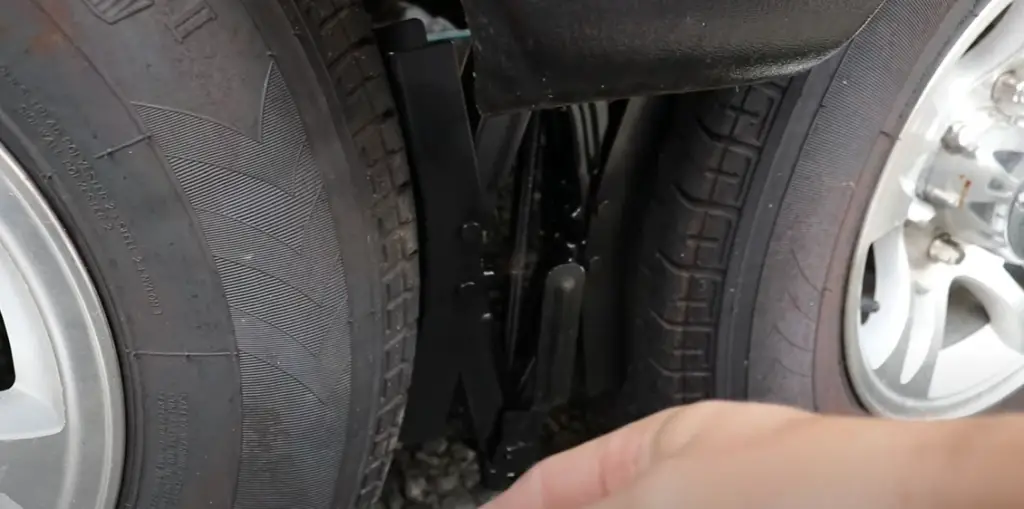
Flexibility and Freedom
One of the best aspects of driving an RV is that it provides you with the flexibility and freedom to travel the way you want. You can choose your own route, stop at any location you want, and stay for as long as you please. There is no need to worry about making hotel reservations or sticking to a strict itinerary when driving an RV. You have the complete freedom to choose your own adventure! [1]
Cost-Effective
Traveling in an RV can be a lot more cost-effective than traditional methods of transportation and accommodation such as airfare and hotel stays. RVs generally have a lower cost per night than hotels, and you save money on meals since you can cook your own food in the RV. Furthermore, the cost of fuel is much less than it would be if you were traveling by plane or car, making RV travel a financially smart option. [1]
Accommodation on-the-go
When you drive an RV, you have your own accommodation on-the-go. You don’t have to worry about booking a hotel room or finding a place to stay. This means you can spend more time exploring and less time worrying about where you will sleep each night. Plus, with the added comfort of having your own bed, bathroom, and kitchen, you can travel in style and comfort!
Bonding Time with Family and Friends
Driving an RV creates the perfect opportunity for bonding time with family and friends. You are all traveling together, sharing the same experiences and creating memories that will last a lifetime. You’ll find that the conversations flow more easily when you’re all sitting around a campfire, and you are able to create a strong sense of togetherness that is hard to achieve in traditional forms of travel. [1]
Nature and Adventure
Driving an RV allows you to get closer to nature and experience adventure in a way that other forms of travel do not. You have the freedom to explore outdoor destinations that might be difficult to get to if you didn’t have your own transportation. From hiking in a national park to camping by a lake, the possibilities for adventure and excitement are endless when driving an RV.
All in all, driving an RV can provide you with a unique and memorable travel experience. With the flexibility and freedom, cost-effectiveness, accommodation on-the-go, bonding time with family and friends, and opportunities for nature and adventure, it’s easy to see why so many people love RV travel. So, why not give it a try for your next family vacation or road trip? You might be surprised at just how much you enjoy exploring the world on four wheels!

The Most Popular Problems When Driving an RV
Driving an RV can be an exciting and liberating experience. The freedom of the open road, the ability to take your home on wheels anywhere you desire, and the chance to meet new people and explore new places are just a few of the reasons why RV travel is becoming increasingly popular. However, like any other mode of transportation, RVs come with their own set of problems. Let’s explore some of the most popular problems that arise when driving an RV and provide tips on how to avoid or handle them.
- Poor Fuel Efficiency
RVs are notorious for their poor fuel efficiency. The large size and weight of RVs mean that they require more fuel to run. On top of this, factors like wind, hills, and poor road conditions can further reduce fuel efficiency. To combat this problem, it’s essential to plan your route carefully and avoid steep inclines and rough terrain. Additionally, try to keep your speed steady and avoid sudden stops or starts which can use more gas. Regular maintenance of your RV’s engine and tire pressure can also help improve fuel efficiency.
- Maneuvering and Parking Difficulties
Driving an RV can be challenging, mainly when it comes to parking and maneuvering in tight spaces. RVs are much larger than the average car, which makes navigating narrow roads, parking lots, and campsites challenging. The best way to handle this problem is to look for campsites and parking spaces that cater to RVs. These spots are often more substantial and have plenty of room for maneuvering. Additionally, take some time to practice driving your RV in an empty parking lot or open space to gain confidence and improve your skills.
- Breakdowns and Flat Tires
RVs are complex machines with many moving parts, which can lead to breakdowns and flat tires. To avoid this problem, it’s crucial to keep up with your RV’s regular maintenance schedule. This means checking your oil, filters, belts, hoses, and other essential components on a regular basis. Additionally, always check your tire pressure before embarking on a trip, and carry a spare tire with you at all times. To avoid getting stranded, consider investing in a roadside assistance plan that covers RVs. [2]
- Electrical and Plumbing Problems
RVs have many electrical and plumbing systems, which can be a source of frustration for many drivers. Issues like leaks, clogs, and faults can arise, causing inconvenience and discomfort. To avoid these problems, it’s essential to educate yourself about your RV’s electrical and plumbing systems. Read the owner’s manual carefully, and learn how to troubleshoot common problems. Additionally, consider investing in a surge protector, which can protect your RV’s electrical system from power surges and voltage fluctuations. [2]
- Weather-Related Hazards
Driving an RV in adverse weather conditions, such as rain, ice, or snow, can be hazardous. Reduced visibility, slick roads, and poor road conditions can increase your risk of an accident. To avoid weather-related hazards, always check the weather forecast before embarking on a trip. If you must drive in inclement weather, slow down, leave plenty of distance between vehicles, and use your wipers and headlights as needed. Be especially careful on hills, bridges, and overpasses, where ice and snow can be more prevalent.
Driving an RV can be a challenging but rewarding experience. By knowing the most popular problems that arise when driving an RV and taking the necessary steps to avoid or handle them, you can enjoy all that RV travel has to offer. Remember to stay up to date on your RV’s maintenance, practice your driving skills, and be prepared for emergencies. With a little bit of preparation and patience, you can hit the road with confidence and experience all the beauty that RV travel has to offer.

Why Is RV Shaking While Driving?
If you’ve been out on the open road in your RV recently, you might have experienced some unusual shaking or vibration while you were driving. These vibrations can be frustrating, distracting, and even a little scary if you’re not sure what’s causing them. Fortunately, there are several reasons why RVs might shake while driving, and most of them are easy to fix with a little bit of maintenance and care.
Here we’re going to explore some of the common causes of RV shaking while driving and provide you with some useful tips on how to address them. Whether you’re a seasoned RV driver or a new owner, this guide will help you keep your vehicle running smoothly and safely on your next road trip.
1) Imbalanced Tires: One of the most common causes of RV shaking while driving is imbalanced tires. If your tires are not balanced correctly, it can create an uneven distribution of weight on your vehicle, causing it to vibrate or shake while you’re driving. Checking your tires’ balance regularly and getting them balanced by a professional mechanic can resolve this issue. Tires also need to be rotated regularly as uneven wear can cause shaking.
2) Worn-out Suspension Parts: Another reason why your RV might be shaking is due to the wear and tear of your suspension parts. These parts are responsible for absorbing road bumps and vibrations. If they wear out, they may not function properly, leading to your RV shaking. Regular maintenance and replacement of suspension parts can help prevent this issue.
3) Damaged or Worn-out Steering Components: Your RV’s steering components, including the tie rods and ball joints, can wear out over time due to regular use and exposure to the elements. When these parts become damaged or worn out, it can cause your RV to shake while you’re driving. It is essential to regularly check these components, and replace or repair them as needed.
4) Uneven Weight Distribution: Uneven weight distribution is another significant cause of RV shaking. If your RV is carrying too much weight on one side, it can cause instability and vibration while you’re driving. Ensure that your RV is loaded and packed evenly, keeping in mind the weight distribution. It would help if you did not put too much weight on the rear of your RV as it affects the safety of your vehicle.
5) Low Tire Pressure: Low tire pressure can also cause your RV to shake while driving. Ensure that your tires are appropriately inflated when you’re on the road. Check the tire pressure regularly as changes in temperature can affect tire pressure, leading to your RV shaking.
RVs shaking while driving is a common issue, but it is important to understand the reasons behind it. Your RV’s tires, suspension parts, steering components, weight distribution, and tire pressure can all contribute to this problem. Regular maintenance and taking the necessary precautions can help prevent this issue from occurring. In summary, check your tires regularly, get them balanced, check your RV’s suspension, replace worn-out steering components, maintain even weight distribution, and ensure appropriate tire pressure. Following these tips will help you have a smooth, comfortable, and safe driving experience in your RV.
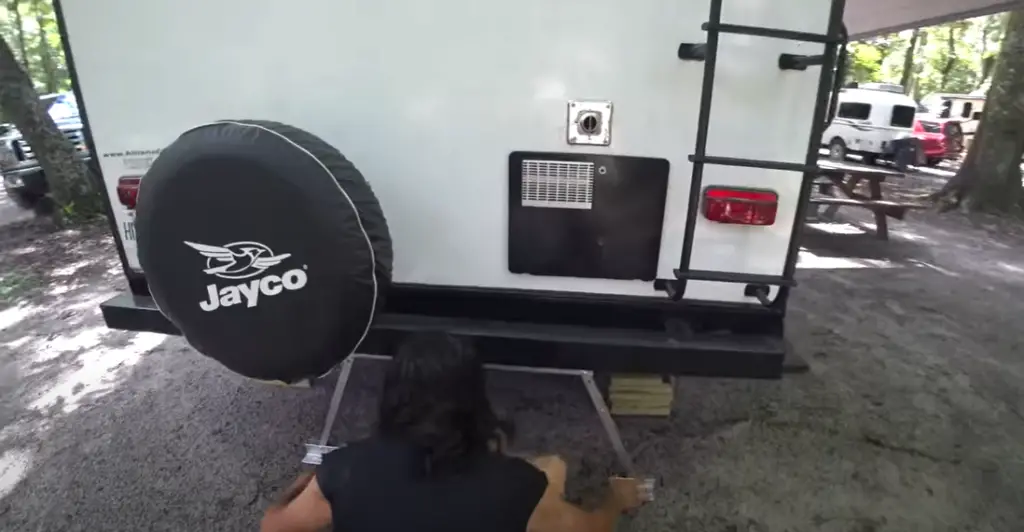
How to Stop My Travel Trailer From Shaking: Step-By-Step Guide
If you’re an avid traveler, chances are you’ve encountered the problem of your travel trailer shaking and vibrating while on the road. Not only is this annoying, but it can also lead to damage and wear and tear on your trailer. Fortunately, there are some simple steps you can take to stop your trailer from shaking and ensure a smoother, more comfortable ride.
Step 1. Check the Tire Pressure
One of the first things you should do if your travel trailer is shaking is to check the tire pressure. Uneven tire pressure can cause your trailer to vibrate, so make sure all tires are properly inflated to the recommended level.
Step 2. Balance Your Wheels
Another cause of trailer shaking could be unbalanced wheels. If your wheels are out of balance, they can cause your trailer to wobble and shake. Make sure to have your wheels balanced before your trip and periodically throughout your travels. [3]
Step 3. Use Stabilizer Jacks
Stabilizer jacks can be a game-changer when it comes to reducing trailer shaking. These jacks are designed to provide additional support to your travel trailer and minimize movement and swaying. Make sure to use them on all four corners of your trailer and adjust them as needed to keep your trailer steady. [3]
Step 4. Install an Anti-Sway Bar
Another way to stop your travel trailer from shaking is to install an anti-sway bar. These bars are designed to control the side-to-side movement of your trailer and keep it stable while on the road. They can be installed on your own or by a professional and can make a huge difference in the way your trailer handles.
Step 5. Pack Your Trailer Strategically
Believe it or not, how you pack your travel trailer can also impact how much it shakes. Be sure to pack heavy items near the front of the trailer, so they don’t shift during your travels. You should also distribute weight evenly on both sides of the trailer to keep it balanced and steady.
Traveling with a shaking travel trailer can be frustrating and uncomfortable, but it doesn’t have to be. By following these simple steps, you can stabilize your trailer, prevent damage and wear and tear, and improve your overall traveling experience. Remember to check tire pressure, balance your wheels, use stabilizer jacks, install an anti-sway bar, and pack your trailer strategically to minimize shaking. Happy travels!
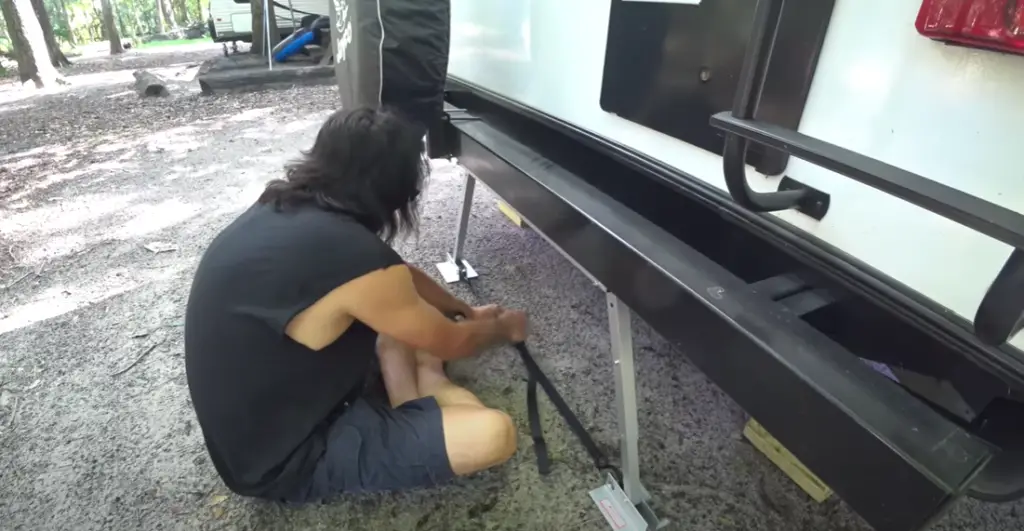
How to Prevent Travel Trailer Shaking
One of the biggest challenges RVers face is trying to find ways to minimize the shaking and movement of their travel trailers, especially when parked on uneven or rough terrain. Travel trailer shaking can be a real nuisance, causing discomfort and distress to everyone inside. Whether you’re a seasoned RVer or just starting out, you’re probably looking for ways to stabilize your travel trailer to prevent it from shaking and swaying. So, if you’re tired of the constant swaying and shaking of your travel trailer and are looking for ways to prevent it from happening altogether, then these tips are for you.
Tip 1. Install Stabilizers
The first step in preventing travel trailer shaking is to install stabilizers. Stabilizers are designed to support the travel trailer’s weight and reduce movement or shaking. They work by distributing the weight of the trailer evenly across the surface, creating a stable foundation. There are different types of stabilizers available, including leveling blocks, scissor jacks, sliders, and tripod stabilizers. Leveling blocks are the most commonly used stabilizers, and they are ideal for uneven terrain. Scissor jacks are easy to use and effective in stabilizing the travel trailer. Sliders are installed underneath the trailer, and they work by shifting the weight of the trailer to prevent shaking. Tripod stabilizers are placed under the trailer’s hitch, and they provide additional support and stability.
Tip 2. Use Wheel Chocks
Wheel chocks are essential for preventing the travel trailer from moving or shaking. They are installed between the trailers’ wheels to stop it from rolling. Wheel chocks are available in various materials, including rubber, plastic, and metal. Ensure that the wheel chocks fit snugly between the wheels to prevent them from slipping.
Tip 3. Add weight to the trailer
Another way to stabilize your travel trailer is to add weight to the trailer. Adding weight will create a stable foundation and prevent the trailer from shifting. However, it’s important to keep in mind that adding too much weight to the trailer can cause damage to the tires, brakes, and axles. The ideal weight for the trailer should be within the manufacturer’s specifications.
Tip 4. Level the Trailer
Leveling the trailer is essential for preventing travel trailer shaking. An uneven trailer can cause the weight to shift, causing the trailer to lean or sway. Use leveling blocks or scissor jacks to level the trailer. The level should be checked frequently to ensure that the trailer is stable.
Tip 5. Wind and Weather
Wind and weather can cause travel trailer shaking. Always check the weather forecast before setting up camp. Avoid setting up camp in areas prone to high winds, such as mountainous areas or open plains. Ensure that the awnings and slide-outs are secured properly to prevent them from shaking or moving in windy conditions.
Reducing travel trailer shaking is essential for a comfortable stay in your travel trailer. Install stabilizers, use wheel chocks, add weight to the trailer, level the trailer, and check the weather forecast to prevent travel trailer shaking. Follow these steps, and you’ll have a more non-shaky and stable vacation trip in your travel trailer.
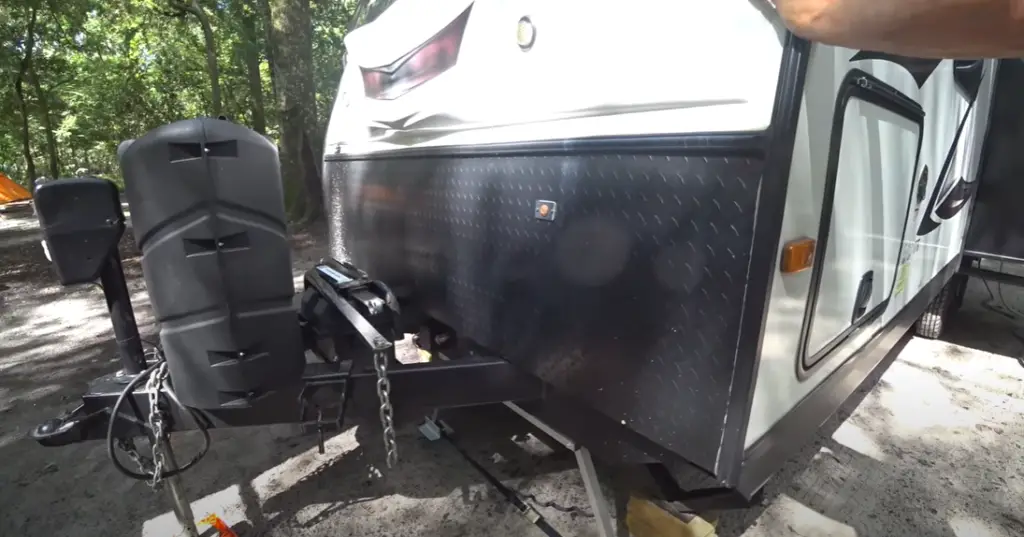
FAQ
Why is my travel trailer so shaky?
The most common reason for a shaky travel trailer is that it’s not level. If your trailer is not level, the weight is not distributed evenly, and this can cause a lot of shaking. Another reason is that the tires may not be properly inflated, or the bearings may need to be greased. The road you’re driving on can also contribute to the shaking – if it’s bumpy or uneven, your trailer may shake more.
How do I stabilize my travel trailer?
The first step in stabilizing your travel trailer is leveling it. You can use leveling blocks or a leveling system to make sure your trailer is level front to back and side to side. Once your trailer is level, you can use stabilizer jacks to reduce the shaking. Stabilizer jacks are placed under the frame of your trailer and help to distribute the weight evenly. There are many different types of stabilizer jacks available, so make sure to choose the one that’s right for your trailer.
How do you balance a camper?
Balancing your camper is essential to reduce the shakiness while you’re inside. There are several ways to balance your camper, including leveling it and placing stabilizer jacks underneath it. You can also add support between the axles to help distribute the weight evenly. If your camper is still shaky after leveling and stabilizing, you may need to make some adjustments to the load you’re carrying or the way you’re driving.
Do travel trailer tires need balancing?
Yes, just like car tires, travel trailer tires need to be balanced. Balancing tires helps to distribute the weight evenly, reducing the shakiness while you’re driving. Make sure to have your travel trailer tires balanced at least once a year or whenever you notice shaking or uneven wear on the tires. It’s also essential to make sure your tires are properly inflated to reduce shaking.
Useful Video: Camper Shakes When Walking Fix
Conclusions
If you’re experiencing shaking or bouncing in your travel trailer, it’s important to take action to prevent this from becoming a safety hazard. Whether you need to balance your trailer, level it properly, tighten its chassis, use stabilizer jacks, or upgrade your tires, there are plenty of steps you can take to improve the stability of your trailer. By following these tips, you can enjoy a safer, more comfortable travel experience on the road.
References:
- https://drifttravel.com/3-advantages-of-traveling-with-an-rv/
- https://www.crossroadstrailers.com/blog/common-rv-problems-you-will-experience-eventually/
- https://rvgoer.com/travel-trailer-shakes/

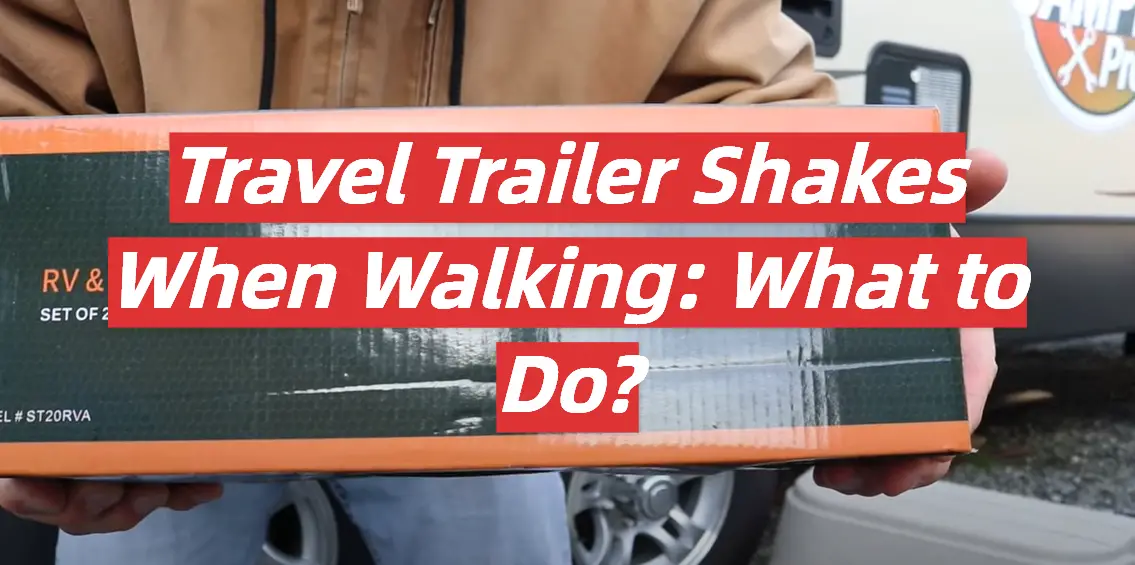




Leave a Reply